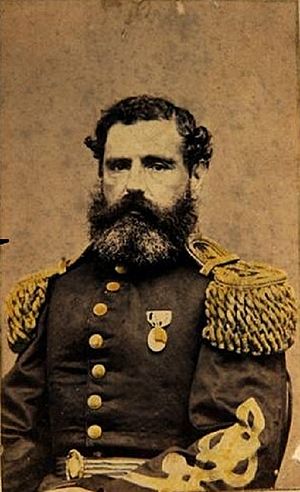León de Pallejas facts for kids
Quick facts for kids
León de Pallejas
|
|
|---|---|
 |
|
| Born | 1816 Seville, Andalusia, Spain |
| Died | July 18, 1866 (aged 50) Ñeembucú, Paraguay |
| Allegiance | |
| Branch | |
| Years of service | 1833 — 1866 |
| Rank | General |
| Unit | Florida Battalion |
| Battles/wars | First Carlist War Argentine Civil Wars Uruguayan Civil War Paraguayan War
|
José Pons de Ojeda (1816 – July 18, 1866), later known as León de Pallejas, was a brave general. He was born in Spain and later became a general in Uruguay. He fought in several important wars, including the First Carlist War, the Argentine Civil Wars, and the Paraguayan War.
Contents
Early Life and Moving to Uruguay
León de Pallejas was born in Seville, Spain, in 1816. His father, Manuel Pons de Palleja, was a surgeon in the Spanish Army.
As a young man, Pallejas fought in the First Carlist War in Spain. This war was about who should be the next king of Spain. When his side lost, he changed his name to León de Pallejas. He then moved to France and later to Uruguay.
Life in Uruguay and Joining the Colorado Party
In Uruguay, Pallejas first worked as a merchant in Paysandú. However, his life changed when Manuel Oribe returned to Uruguay in 1842. Pallejas decided to join the supporters of Fructuoso Rivera. He became part of the Colorado Party.
He started as a private soldier. Later, he showed his skills to General José María Paz. Pallejas proved to be a very brave and skilled leader. He was known for being tough but also fair to his soldiers. Because of his abilities, he was promoted to colonel.
Defending Montevideo
During the Great Siege of Montevideo, Pallejas showed his strong leadership. This was a long battle where the city of Montevideo was surrounded. His courage and ability to command were noticed by everyone.
Fighting in the Argentine Civil Wars
Pallejas joined the Ejército Grande (Great Army) led by Justo José de Urquiza. This army fought against Juan Manuel de Rosas in Argentina. Pallejas led a group of soldiers called the "Voltígeros" battalion.
He fought bravely in the Battle of Caseros. This battle was a major event in the Argentine Civil Wars. Pallejas was one of the first to enter a key area during the battle.
Later Years and the Paraguayan War
After the wars in Argentina, Pallejas returned to Montevideo. He supported General César Díaz in a revolution in 1853. This revolution removed President Juan Francisco Giró from power.
Pallejas then supported the new president, Venancio Flores. When Flores was overthrown, Pallejas left the military for a while. He spent time working on a farm in the Durazno Department.
Joining the Paraguayan War
In 1863, Venancio Flores invaded Uruguay. The president at the time, Bernardo Prudencio Berro, had Pallejas arrested. This was because he thought Pallejas might help Flores.
Pallejas was released after Berro's government fell. He then formed a group of soldiers called the "Florida" battalion. With this battalion, he marched to fight in the Paraguayan War. Even though he privately disagreed with the war, he led his soldiers very well.
Pallejas as a Leader
Pallejas was known for being a very demanding leader in battle. He expected the best from his soldiers. He would yell and push them, but he also treated them like equals outside of battle. He was not afraid of danger himself. He once said, "In order to die, you don't need regulations," showing his fearless attitude.
He sent many letters from the front lines to newspapers in Montevideo. These letters are now important historical records of the war. He fought in several major battles under Venancio Flores, including:
- Battle of Yatay
- Siege of Uruguaiana
- Battle of Estero Bellaco
- Battle of Tuyutí
Death in Battle
León de Pallejas fought his last battle at the Battle of Boquerón in 1866. He showed great bravery again but was sadly killed during the fighting.
There are photos of him taken just days before this battle. There is also a photo of his soldiers moving his body. These pictures were taken by photographers Bate & Cia. After his death, he was given the rank of general.
Images for kids
See also
 In Spanish: León de Palleja para niños
In Spanish: León de Palleja para niños


